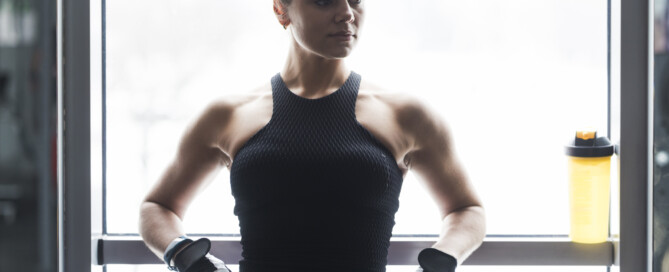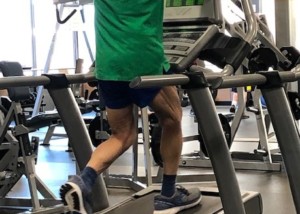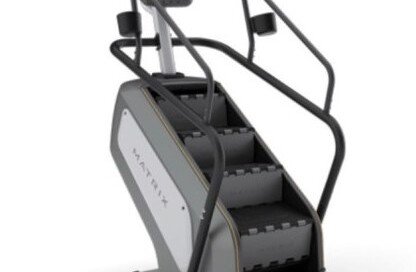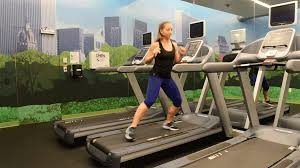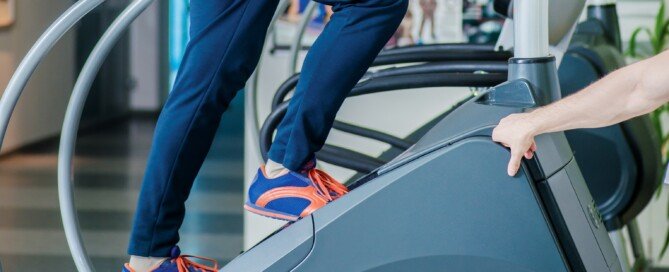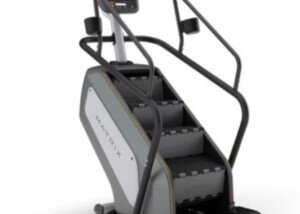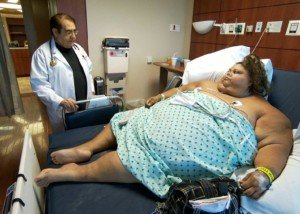Get a Super Strong Core with These 10 Moves

Here is the top 8 list for low back exercises for building your strongest core ever. (more…)
Stationary Bike Exercise Guidelines for Heavy Beginners
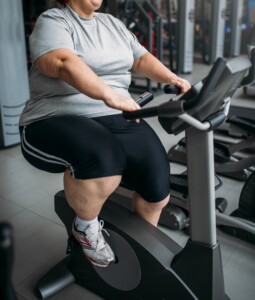
Here are ALL the indoor cycling tips for the obese or overweight woman or man who wants to pedal for fitness and fat loss.
Indoor cycling including the spin class can burn a substantial amount of fat for even novice obese and overweight exercisers.
There are two kinds of “indoor cycling”: use of a stationary bike in the cardio equipment section of a gym or your own home; and use of the bike in a spin class.
I’ve noticed that spin classes do not attract many obese or overweight participants, which is puzzling, because this type of format should be inviting to self-conscious exercisers.
The room is on the dim side, and there is little distinction between the lean buff participants and any very overweight participants in a spin class, in that all body types are doing the same thing: sitting and pedaling.
Spin Class Tips
Check out the equipment during non-class time and get familiar; take the bike for a little spin to get a feel for it.
A small thin cushion will ease initial seat discomfort. For the actual class, bring a towel.
If the seat becomes uncomfortable, join the crowd: This is a common issue and diminishes over time. Don’t let this stop you from subsequent participation in a spin class.
Bring ear plugs if the music is too loud; sometimes spin class instructors crank the volume up all the way. It’s perfectly okay to request a reduction in volume!
Keep your hands light on the handlebars. Don’t use a death grip.
If the instructor calls for a standing position while pedaling, make sure there is enough resistance on the flywheel to allow for a stable, smooth pedaling stroke.
If you decide a spin class is not your cup of tea, and decide to just use a stationary bike in the cardio section of the gym or at home, then the No. 1 rule is to abandon reading while pedaling.
The minute you start reading, you’ll lose focus and merely go through lame pedaling motions. This is a guaranteed result.
To make indoor cycling outside of a spin class burn the most fat — not just during the pedaling but for hours after you get off the bike, apply a simple technique called HIIT: high intensity interval training.
 Lorra Garrick is a former personal trainer certified through the American Council on Exercise. At Bally Total Fitness she trained women and men of all ages for fat loss, muscle building, fitness and improved health.
Lorra Garrick is a former personal trainer certified through the American Council on Exercise. At Bally Total Fitness she trained women and men of all ages for fat loss, muscle building, fitness and improved health.
.
Top image: Shutterstock/Nomad_Soul
Fun Staircase Workouts for Burning Fat

If you have access to just one staircase, that’s all you need for this workout, but a few flights are even better. (more…)
Should Older Runners Quit and Walk Instead for Safety?

If you’ve been running for years but are wondering if now you’re too old to jog, here is some striking information you can’t ignore. (more…)
Pushups with Feet on a Fitness Ball vs. Regular Pushups

Will you build more strength by doing pushups with your feet on one of those big “stability” balls, or should you just stick with the tried-and-true regular pushup?
(more…)
Using Stair Climber Sideways: Fad or Beneficial Way to Exercise?
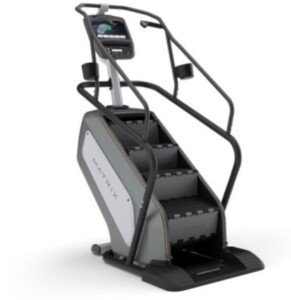
Many people use the stair climber sideways, but are they only fooling themselves?
Using the stair climber sideways adds a unique spin to step exercise. I’m a former certified personal trainer and have used the stair climber sideways – with my hands always free, never holding on; this is the correct way to do it.
Most of the benefits of stepping this way are lost when you hold onto the rails.
Every person I’ve ever seen stepping sidewise on the stair climber was holding on. Not holding on totally changes the exercise – for the better.
What’s wrong with holding on while you use the stair climber sideways?
-It causes bad posture.
Watch anyone using this machine with the side stepping. Almost always, they are quite crooked and/or hunched over a bit. Every single time.
Holding on encourages leaning, and because the rails become the support, the body’s inner support system slacks off considerably.
The result is a bent-over posture and/or one that’s leaning towards the side of the hand that’s doing most of the holding. I don’t know how people can do this; it looks so uncomfortable.
-It reduces a lot of workload. I’m sure that many women who use the stair climber sideways do so for toning emphasis of specific lower body muscle groups.
Holding on for support will de-emphasize the targeted muscles.
-It doesn’t improve balance or coordination. Though improving balance/coordination may not be the reason one uses the stair climber sideways, why eliminate the added benefit of improved balance by holding on?
It’s great when a workout not only tones muscles and improves cardio function, but also improves balance.
You can get all three benefits by using a hands-off approach.
How does one use the stair climber sideways without holding on?
Start at level 1, stand straight, shoulders as square as possible, and just start moving.
Watch your feet! When I go sideways on the stair climber, I watch my feet.
Holding on eliminates this task, but I’d much rather keep my eyes on my feet for much of the time if it means a far more efficient workout.
Sometimes I can look up and about as I get into the rhythm, but for the most part, I’m watching my feet.
Keeping your hands off will force you to maintain a much better posture, though watching your feet will prevent a perfectly straight spine, but again, at least posture will be much better (not crooked) than if you’re holding the rails.
You will burn more calories! Balancing burns calories. When you throw balancing into the mix, the total calorie burn is greater.
The machine’s calorie reading will be the same, though, since a machine can’t tell whether or not your hands are on the rail.
As you get used to sideways stepping on the stair climber, increase the speed.
You will feel a marked difference in muscle recruitment as you progress into your session of walking sideways on the stair climber.
You will also feel that you got much more out of the workout after doing it without holding on.
 Lorra Garrick is a former personal trainer certified through the American Council on Exercise. At Bally Total Fitness she trained women and men of all ages for fat loss, muscle building, fitness and improved health.
Lorra Garrick is a former personal trainer certified through the American Council on Exercise. At Bally Total Fitness she trained women and men of all ages for fat loss, muscle building, fitness and improved health.
Is Using a Stair Climber Backwards Beneficial or Worthless?

Find out the truth about backwards walking on the stair climber (revolving staircase).
It’s not uncommon to see someone using the stair climber machine backwards.
I’m a huge proponent of keeping one’s hands off the elliptical, treadmill and stair climber (a.k.a. revolving staircase) when using them conventionally.
I also heavily endorse the hands-free approach even when using a treadmill (and elliptical) backwards.
What about going backwards on the stair climber?
My take is to skip this altogether. It is just too loppy to reap any benefits because it forces the feet to be placed on the steps in a totally unnatural manner: front of foot hanging off the step.
Normally, when you climb stairs, the back part of the foot hangs off a little, sometimes more than a little; usually, only the ball of the foot makes contact. Sometimes maybe just about all of the foot makes contact.
In either case, the front of the foot always makes contact. When using the stair climber backwards, the opposite occurs.
The heel strikes first, and the front-most portion of the foot never makes contact (unless you have unbelievably tiny feet).
This alone is the deal breaker for me. Ask yourself just why you want to use the stair climber backwards.
”Ask someone why they’re exercising backwards and they’ll usually tell you they’re trying to tone their butt and the backs of their legs,” says Ben Gelfand, a physical therapist with decades of experience treating a variety of patient populations
Backwards movement on the stair climber recruits less of the gluteal muscles than does stepping forward.
One reason is because the structure of the stepping device eliminates the hip extension necessary for full gluteal use, and so the opposite occurs: minimal hip extension.
What is hip extension? Ever see someone on the stair climber stepping forward, but after each step, the opposite leg is thrust out behind that person in an exaggerated fashion?
That’s hip extension, and that will work the butt. There’s more hamstring use here too.
Backwards stepping on the stair climber is “also not great for the lower back because your posture and body alignment are thrown out of whack,” says Gelfand.
Holding onto the rails causes this problem, yet letting go would be precarious unless you go at level 1, and even then, some people will struggle without holding on.
Solution? Skip the backward climbing on the revolving staircase.
 Ben Gelfand is the founder of Professional’s Hip Center of Excellence.
Ben Gelfand is the founder of Professional’s Hip Center of Excellence.
 Lorra Garrick is a former personal trainer certified through the American Council on Exercise. At Bally Total Fitness she trained women and men of all ages for fat loss, muscle building, fitness and improved health.
Lorra Garrick is a former personal trainer certified through the American Council on Exercise. At Bally Total Fitness she trained women and men of all ages for fat loss, muscle building, fitness and improved health.
.
Top image: Shutterstock/Maksym Poriechkin
Source: nytimes.com/1998/10/13/health/no-gain-in-backward-exercise-experts-say.html
Exercising Before You Eat Breakfast: Pros and Cons

So should you exercise before breakfast or work out after breakfast?
What a conundrum for many health-conscious people including those who are struggling to lose weight.
“Some people feel great working out on an empty stomach and can get through a workout just fine,” says Sara Artigues, a registered dietician and certified personal trainer out of New Orleans.
“There are some theories that working out while still ‘fasting’ taps into fat stores after your stored glucose (in short supply after fasting all night) is used up.”
“Working out when you haven’t eaten at all yet, your body is relying solely on stored energy.
“Depending on when you had dinner the night before, what it consisted of, and your personal metabolism/digestive system, you may be able to get a great workout in while still ‘fasting’ from the night before.
“Others may feel lightheaded and weak trying to exercise on a completely empty stomach.”
Here are some very interesting variables you should consider:
• Your general state of physical durability. Some people have a high threshold for physical punishment following an overnight fast before adverse effects begin setting in.
• Some people may feel weighed down when exercising hard on a full stomach. They may worry that some of their body’s energy is being diverted to digestion rather than fully on the workout.
• Type of exercise also must be considered. A person generally doesn’t need to have breakfast before doing 30 minutes of steady-state walking on a treadmill.
• Food in one’s stomach, while that person does jumping drills or sprints, might give them stomach discomfort.
• Diabetes and pregnancy mean a certain breakfast before any exercise, though the breakfast need not be full-course such as a bowl of cereal, two pieces of toast with jam, coffee and a blueberry muffin.
• You may begin exercising on an empty stomach in the morning, but then every 15 minutes munch on grapes, apple slices, or sip a fruit smoothie or kefir.
• But remember this: Nobody ever failed at a weight loss plan because they had a little something to eat prior to a morning workout.
Breaking the fast does not mean three pancakes smothered in butter, a few sausage links, two eggs and a glass of orange juice – a meal laden with simple carbohydrates and processed fare — before you go head off to the gym.
“For those who need a small pickup early morning, choose a light (low fat) whole grain bar, one-half banana or other piece of fruit, one piece of toast w/ cream cheese or peanut butter if that settles well with you,” suggests Artigues.
“Nothing very heavy. When you eat a healthy breakfast afterward, you’re replenishing your body providing repair and rebuilding of the muscle breakdown by eating protein, and replenishing of glucose stores for energy.
“Have a meal consisting of lean protein, complex carbs and if possible, vegetables for the best post-workout breakfast.
“It’s also helpful have this meal within two hours of finishing your workout. Don’t forget to hydrate with water too!”
Hard Workout on Empty Stomach in the Morning: Training for a Crisis
A healthy person may want to consider skipping breakfast before a tough workout – in the name of training their body to adapt to physical exertion on top of an overnight fast.

Freepik.com
The reason? You’ll never know when you’ll be placed in this circumstance: a morning emergency and no time to eat first.
Or, the emergency that requires physical exertion may occur later in the day – when your stomach has been empty for several hours.
Sure, you may be able to grab a peach or banana amid the crisis, but there may also be an event in which you’re not able to think about food, and instead are thrust into emergent physical exertion (e.g., having to physically move acutely-ill person; intercepting a crime; house is flooded – who knows?!).
However, if you want to train your body to be more durable with physical exertion minus a preceding breakfast, it’s wise that you do this with fast-acting carbs on hand.
 Lorra Garrick is a former personal trainer certified by the American Council on Exercise. At Bally Total Fitness she trained clients of all ages for fat loss, muscle building, fitness and improved health.
Lorra Garrick is a former personal trainer certified by the American Council on Exercise. At Bally Total Fitness she trained clients of all ages for fat loss, muscle building, fitness and improved health.
 Sara’s training services include fitness/body composition assessments, nutrition planning, customized programs and spin class instruction for a variety of clients.
Sara’s training services include fitness/body composition assessments, nutrition planning, customized programs and spin class instruction for a variety of clients.
.
Top image: Shutterstock/F8 studio
Can A Woman with Prominent Collarbones Be Healthy?

Prominent clavicles are beautiful and in many women indicate a healthy body fat percentage, not an eating disorder!
I was inspired to write this article (finally) after seeing quite a few episodes of “The Golden Girls.”
The character of Blanche, played by Rue McClanahan, often wears dresses revealing her entire shoulders — including the clavicles — or shall I say, lack thereof.
I’ve always thought of how unattractive this was; no landscape, no definition, just one solid mass of mush.
Then one day I had a freak fall and broke my collarbone. It healed and one day I realized I could hold water in the depression that my clavicle borders.
I then did some googling and, to my surprise, learned that several years ago a fad apparently originated in Weibo, China, in which women were placing coins on top of their collarbones—a sign of thinness.
The critics soon chimed in, stating that this was yet another fixation of a skinny-obsessed culture, promoting eating disorders and unhealthy body weights.
Check out my very visible clavicles to the left, as the image at the top shows.
I am very healthy and fit, a former personal trainer.
I do fierce gym workouts with very heavy weights, plus intense interval cardio. I go on long hikes and feel great afterwards.
Having very little fat around the clavicles doesn’t mean a woman isn’t healthy and fit.
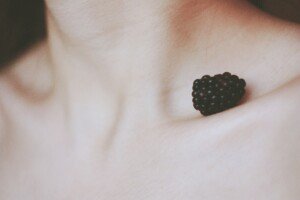
In fact, with all the heavy weightlifting I do, my clavicles (like the rest of my bones) are dense and strong, since weight-bearing exercise stimulates bone growth.
Granted, we all know that there are thin women who don’t get enough nutrition and have weak, untrained muscles—whose collarbones show prominently.
But the prominent visibility of clavicles, in and of itself, should not be a marker for being unhealthy or underweight.

Now take a look at the shoulder and arm that goes with my prominent clavicle, and tell me if you think I’m undernourished, weak and unhealthy.
Do not be alarmed if your clavicle bones show. If you’re concerned about health and fitness, start lifting weights and increase your intake of fruits, vegetables, nuts and fish.
Weightlifting will increase your bone density and strengthen your musculoskeletal system.
- Restrict your consumption of junk food.
- Don’t smoke.
- Drink treated water rather than tap water.
- Replace white rice with brown rice or boiled potatoes.
If anything signifies lack of fitness, it’s a clavicle region like Rue McClanahan’s — not visible on her right, barely visible on her left.

Rue McClanahan
This points towards the so-called skinny-fat body: a body that fits into a size single-digit dress, but the body composition is a higher ratio of fat to muscle.
According to the American Council on Exercise, a body fat percentage of 14-20% in women is considered “athletes.”
And 21-24% is considered “fitness.” And 10-13% is considered “essential.”
Prominent collarbones, hence, do not mean a woman has an eating disorder or is too thin, even though a too-thin woman may have protruding clavicles, and even more commonly, simply visible clavicles.
There is nothing wrong with women proudly sporting their clavicles.
A padded layer of fat over them will not necessarily make such a woman healthier.
Doctors do not assess health, during a routine physical, by examining the visibility or prominence of collarbones.
Instead, doctors note your blood pressure, fasting blood sugar, listen to your heart, examine inside your mouth and conduct other classic tests for health and well-being.
The clavicles of many professional or competitive female athletes who have very healthy diets are frequently prominent.
 Lorra Garrick is a former personal trainer certified through the American Council on Exercise. At Bally Total Fitness she trained women and men of all ages for fat loss, muscle building, fitness and improved health.
Lorra Garrick is a former personal trainer certified through the American Council on Exercise. At Bally Total Fitness she trained women and men of all ages for fat loss, muscle building, fitness and improved health.
Why Your Legs Twitch when You Use the Computer


